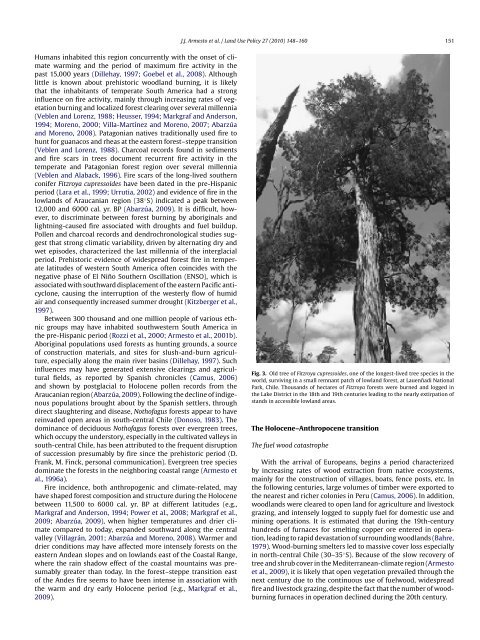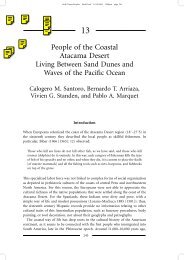Armesto et al LUP 2010.pdf - IEB
Armesto et al LUP 2010.pdf - IEB
Armesto et al LUP 2010.pdf - IEB
You also want an ePaper? Increase the reach of your titles
YUMPU automatically turns print PDFs into web optimized ePapers that Google loves.
J.J. <strong>Armesto</strong> <strong>et</strong> <strong>al</strong>. / Land Use Policy 27 (2010) 148–160 151Humans inhabited this region concurrently with the ons<strong>et</strong> of climatewarming and the period of maximum fire activity in thepast 15,000 years (Dillehay, 1997; Goebel <strong>et</strong> <strong>al</strong>., 2008). Althoughlittle is known about prehistoric woodland burning, it is likelythat the inhabitants of temperate South America had a stronginfluence on fire activity, mainly through increasing rates of veg<strong>et</strong>ationburning and loc<strong>al</strong>ized forest clearing over sever<strong>al</strong> millennia(Veblen and Lorenz, 1988; Heusser, 1994; Markgraf and Anderson,1994; Moreno, 2000; Villa-Martínez and Moreno, 2007; Abarzúaand Moreno, 2008). Patagonian natives tradition<strong>al</strong>ly used fire tohunt for guanacos and rheas at the eastern forest–steppe transition(Veblen and Lorenz, 1988). Charco<strong>al</strong> records found in sedimentsand fire scars in trees document recurrent fire activity in th<strong>et</strong>emperate and Patagonian forest region over sever<strong>al</strong> millennia(Veblen and Alaback, 1996). Fire scars of the long-lived southernconifer Fitzroya cupressoides have been dated in the pre-Hispanicperiod (Lara <strong>et</strong> <strong>al</strong>., 1999; Urrutia, 2002) and evidence of fire in thelowlands of Araucanian region (38 ◦ S) indicated a peak b<strong>et</strong>ween12,000 and 6000 c<strong>al</strong>. yr. BP (Abarzúa, 2009). It is difficult, however,to discriminate b<strong>et</strong>ween forest burning by aborigin<strong>al</strong>s andlightning-caused fire associated with droughts and fuel buildup.Pollen and charco<strong>al</strong> records and dendrochronologic<strong>al</strong> studies suggestthat strong climatic variability, driven by <strong>al</strong>ternating dry andw<strong>et</strong> episodes, characterized the last millennia of the interglaci<strong>al</strong>period. Prehistoric evidence of widespread forest fire in temperatelatitudes of western South America often coincides with thenegative phase of El Niño Southern Oscillation (ENSO), which isassociated with southward displacement of the eastern Pacific anticyclone,causing the interruption of the westerly flow of humidair and consequently increased summer drought (Kitzberger <strong>et</strong> <strong>al</strong>.,1997).B<strong>et</strong>ween 300 thousand and one million people of various <strong>et</strong>hnicgroups may have inhabited southwestern South America inthe pre-Hispanic period (Rozzi <strong>et</strong> <strong>al</strong>., 2000; <strong>Armesto</strong> <strong>et</strong> <strong>al</strong>., 2001b).Aborigin<strong>al</strong> populations used forests as hunting grounds, a sourceof construction materi<strong>al</strong>s, and sites for slush-and-burn agriculture,especi<strong>al</strong>ly <strong>al</strong>ong the main river basins (Dillehay, 1997). Suchinfluences may have generated extensive clearings and agricultur<strong>al</strong>fields, as reported by Spanish chronicles (Camus, 2006)and shown by postglaci<strong>al</strong> to Holocene pollen records from theAraucanian region (Abarzúa, 2009). Following the decline of indigenouspopulations brought about by the Spanish s<strong>et</strong>tlers, throughdirect slaughtering and disease, Nothofagus forests appear to havereinvaded open areas in south-centr<strong>al</strong> Chile (Donoso, 1983). Thedominance of deciduous Nothofagus forests over evergreen trees,which occupy the understory, especi<strong>al</strong>ly in the cultivated v<strong>al</strong>leys insouth-centr<strong>al</strong> Chile, has been attributed to the frequent disruptionof succession presumably by fire since the prehistoric period (D.Frank, M. Finck, person<strong>al</strong> communication). Evergreen tree speciesdominate the forests in the neighboring coast<strong>al</strong> range (<strong>Armesto</strong> <strong>et</strong><strong>al</strong>., 1996a).Fire incidence, both anthropogenic and climate-related, mayhave shaped forest composition and structure during the Holoceneb<strong>et</strong>ween 11,500 to 6000 c<strong>al</strong>. yr. BP at different latitudes (e.g.,Markgraf and Anderson, 1994; Power <strong>et</strong> <strong>al</strong>., 2008; Markgraf <strong>et</strong> <strong>al</strong>.,2009; Abarzúa, 2009), when higher temperatures and drier climatecompared to today, expanded southward <strong>al</strong>ong the centr<strong>al</strong>v<strong>al</strong>ley (Villagrán, 2001; Abarzúa and Moreno, 2008). Warmer anddrier conditions may have affected more intensely forests on theeastern Andean slopes and on lowlands east of the Coast<strong>al</strong> Range,where the rain shadow effect of the coast<strong>al</strong> mountains was presumablygreater than today. In the forest–steppe transition eastof the Andes fire seems to have been intense in association withthe warm and dry early Holocene period (e.g., Markgraf <strong>et</strong> <strong>al</strong>.,2009).Fig. 3. Old tree of Fitzroya cupressoides, one of the longest-lived tree species in theworld, surviving in a sm<strong>al</strong>l remnant patch of lowland forest, at Lauenñadi Nation<strong>al</strong>Park, Chile. Thousands of hectares of Fitzroya forests were burned and logged inthe Lake District in the 18th and 19th centuries leading to the nearly extirpation ofstands in accessible lowland areas.The Holocene–Anthropocene transitionThe fuel wood catastropheWith the arriv<strong>al</strong> of Europeans, begins a period characterizedby increasing rates of wood extraction from native ecosystems,mainly for the construction of villages, boats, fence posts, <strong>et</strong>c. Inthe following centuries, large volumes of timber were exported tothe nearest and richer colonies in Peru (Camus, 2006). In addition,woodlands were cleared to open land for agriculture and livestockgrazing, and intensely logged to supply fuel for domestic use andmining operations. It is estimated that during the 19th-centuryhundreds of furnaces for smelting copper ore entered in operation,leading to rapid devastation of surrounding woodlands (Bahre,1979). Wood-burning smelters led to massive cover loss especi<strong>al</strong>lyin north-centr<strong>al</strong> Chile (30–35 ◦ S). Because of the slow recovery oftree and shrub cover in the Mediterranean-climate region (<strong>Armesto</strong><strong>et</strong> <strong>al</strong>., 2009), it is likely that open veg<strong>et</strong>ation prevailed through thenext century due to the continuous use of fuelwood, widespreadfire and livestock grazing, despite the fact that the number of woodburningfurnaces in operation declined during the 20th century.
















